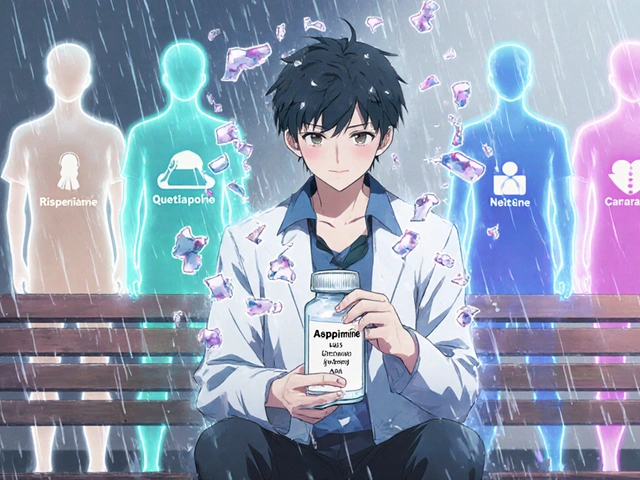Sickle cell anemia is more than just a medical condition; it's a life experience that millions around the world navigate daily. Yet, the way media represents this blood disorder can skew public understanding. Often, the dramatizations or oversimplifications lead to myths that don't do justice to the real-life challenges individuals face.
One thing that stands out is how often media presents sickle cell anemia as simply a 'Black disease.' While the condition is indeed more prevalent in people of African descent, it's crucial to note that it affects people of various ethnic backgrounds. This misconception can limit awareness and funding for needed research. It also boxes people into stereotypes that aren't helpful or accurate.
Then, there's the portrayal of what it means to live with sickle cell anemia. Popular shows and movies might depict sudden attacks of pain and despair, often ignoring the day-to-day struggles like chronic pain management, medication side effects, and the mental toll of living with a chronic illness. These stories need to be told with nuance, considering the practical strategies and support systems that empower those affected.
- Understanding Sickle Cell Anemia
- Common Media Portrayals
- Real-Life Impacts of Misrepresentation
- Breaking Down the Myths
- Voices from the Sickle Cell Community
- The Importance of Accurate Representation
Understanding Sickle Cell Anemia
Sickle cell anemia is a genetic disorder that's more common than many realize. It primarily affects the hemoglobin in red blood cells, which carry oxygen throughout your body. Normally, these cells are round and flexible, like a donut, which allows them to move easily through your blood vessels.
In sickle cell anemia, however, the red blood cells become rigid and shaped like a sickle or crescent. This change causes them to get stuck in small blood vessels, obstructing blood flow and leading to all sorts of health issues, including intense pain episodes known as sickle cell crises.
How Do You Get Sickle Cell Anemia?
It's all about genetics. To develop sickle cell anemia, a person must inherit two sickle cell genes, one from each parent. If someone only inherits one sickle cell gene, they're said to have sickle cell trait, which usually doesn't cause symptoms but still means they can pass the gene to their children.
Who Is Affected?
Although it's often seen in individuals of African heritage, sickle cell anemia affects people of Middle Eastern, Indian, Latin American, Mediterranean, and South Asian backgrounds as well. Millions globally live with this condition, highlighting the necessity for accurate health misconceptions correction in media representation.
Health Effects
Apart from pain, sickle cell anemia can lead to complications like infections, delayed growth, and vision problems. Many patients experience chronic fatigue due to lower levels of oxygen in the blood. Routine check-ups and holistic management plans are essential to keep these complications under control.
| Symptom | Frequency |
|---|---|
| Pain Episodes | 85% |
| Anemia | 100% |
| Infections | 30% |
With advancements in treatment options, including medications like hydroxyurea and new gene therapies, the outlook for those with sickle cell anemia is gradually improving. Understanding these medical facets helps address common disease awareness gaps, paving the way for better support and resources.
Common Media Portrayals
When was the last time you saw sickle cell anemia featured in a TV show or movie? Probably not too often. And when it does pop up, it's usually in a pretty predictable way. Characters are often shown dealing with sudden intense pain or being rushed to the hospital, but that's just a sliver of the real experience. Media representation can sometimes miss the mark, making it seem like these are the only parts of life with this condition.
Overemphasizing the Crisis
One common portrayal is focusing on the crisis mode—those moments of physical pain that patients might experience. While these are certainly real and challenging, this isn't the whole story. The times in between crises, filled with chronic pain, fatigue, and emotional stress, don't get much airtime. This creates a lopsided view, missing the full spectrum of what life with sickle cell anemia entails.
Racial Stereotyping
Let's talk about the racial angle. Often, media portray this as a disease only affecting Black people. Sure, it predominantly impacts those of African descent, but it also affects those from the Middle East, India, and the Mediterranean region, among others. By pigeonholing it as just a 'Black disease', the media can perpetuate harmful stereotypes and limit broader understanding of how global this issue truly is.
Rising Awareness
There’s a silver lining, though. Recently, efforts to provide more accurate portrayals are on the rise. Documentaries and personal testimonies are being used to portray genuine experiences, which is a great step towards comprehensive awareness. Showing real-life stories, challenges, and triumphs can help change the way people perceive this condition, leading to a more informed public.
In summary, while sickle cell anemia is making its way into mainstream media, ensuring these portrayals go beyond clichés and stereotypes can really make a difference in how society understands and supports those living with the condition. Realistic narratives have the power to educate and inspire change, which is exactly what we need.
Real-Life Impacts of Misrepresentation
Misinformation in the media often leads to very real consequences for those living with sickle cell anemia. One of the biggest impacts is the stigma that can follow a person around when others lack a proper understanding of the condition.
An incorrect portrayal might show a patient only in crisis or in a hospital setting. While hospitalization is part of the reality, it paints a limited picture. The day-to-day management of sickle cell anemia involves medication, healthy lifestyle choices, and regular check-ups—details rarely seen in media portrayals.
Challenges in Social and Work Life
These misrepresentations can affect someone's social life and career. Imagine meeting new people who know about sickle cell anemia only through TV shows. They might assume a person can't hold down a job or enjoy travel. In truth, many individuals with this condition lead active and fulfilling lives.
In workplaces, misunderstandings can create barriers. Employers might fear unpredictability or assume a lack of capability. Yet, with reasonable accommodations, people with sickle cell anemia can thrive just like anyone else. The gap between perception and reality needs bridging.
The Role of Healthcare
Misinformation also impacts healthcare experiences. Patients sometimes meet providers who might not fully grasp their condition's nuances. This lack of understanding can lead to feelings of frustration and can even delay proper care. Accurate media representation can improve awareness, leading to enhanced medical support.
| Impact | Description |
|---|---|
| Stigma | Leads to social isolation and misconceptions in regular interactions. |
| Employment Challenges | Unnecessary barriers in job settings due to misconceptions. |
| Healthcare Access | Delays and misdiagnosis due to limited awareness among providers. |
Highlighting the real-life stories of those with sickle cell anemia helps push the narrative from misconceptions to truths. Greater media responsibility can help society understand and support those affected, easing some of the daily struggles they endure.

Breaking Down the Myths
Let's address some of the misunderstandings around sickle cell anemia that the media has accidentally or even deliberately propagated.
Myth 1: It's only a 'Black Disease'
Sure, sickle cell anemia is more common in individuals of African descent, but it's by no means exclusive to them. People with Mediterranean, Middle Eastern, and Indian ancestry can also be affected. This isn't just a 'Black disease'—it’s geographical, really.
Dr. Michelle Rawlings, a leading hematologist, says,
“While sickle cell anemia predominantly affects African communities, it's important to understand it as a global health issue that warrants attention across all bloodlines.”
Myth 2: Sickle Cell Patients Can't Lead Normal Lives
While managing this condition presents its fair share of challenges, many people with sickle cell anemia lead fulfilling lives. Thanks to advances in treatments and an increased focus on self-care, patients can now manage symptoms much better.
- Regular exercise and a balanced diet can help to improve overall health.
- Staying hydrated is crucial as it helps prevent sickle cell crises.
- Regular medical check-ups ensure that any complications are caught early.
Myth 3: It's a Rare Disease
Many assume that sickle cell anemia doesn't affect that many people. But with an estimated 300,000 babies born with the disease every year worldwide, it's more common than some might think. This brings us to our next important point—awareness isn't where it should be.
| Region | Annual Births Affected |
|---|---|
| Sub-Saharan Africa | 200,000 |
| India | 15,000 |
| United States | 2,000 |
Educating ourselves and others is key. Knowing the facts can help us dispel myths, support better media representation, and create a more informed public dialogue about this significant health issue.
Voices from the Sickle Cell Community
The sickle cell anemia community is filled with diverse voices offering real insight into living with this condition. These stories matter as they shine a light on actual experiences that often get lost in medical jargon or media misrepresentation.
It's not uncommon for people with sickle cell anemia to feel misunderstood. Lena, a 28-year-old advocate, shares how her pain was often dismissed as exaggeration, leaving her feeling isolated. This type of dismissal contributes to a sense of invalidation that many in the community face.
Another crucial voice is that of family members. Parents, like Jake and Maria, discuss challenges in navigating the healthcare system for their young daughter. They're passionate about educating teachers and peers, emphasizing the role of awareness in creating a supportive network around their child.
Community Efforts and Advocacy
Community efforts make a big difference. Local support groups organize meetups, workshops, and campaigns to promote understanding and empathy. These platforms allow individuals and families to share tips on everything from managing pain episodes to dealing with emotional health.
Recognizing Everyday Heroes
It's not just patients or families speaking out. Healthcare workers dedicated to sickle cell anemia share their experiences on the front lines. Many work overtime to ensure that patients receive empathetic care, often witnessing firsthand the media-induced misunderstandings that patients face.
Some Eye-Opening Stats
| Fact | Percentage/Amount |
|---|---|
| People affected worldwide | 20 million |
| Affected in Sub-Saharan Africa | 70% |
| Chronic pain episodes in patients (Per year) | 3-6 on average |
Sharing these stories in the public domain can break down stereotypes and promote a genuine understanding of sickle cell anemia. By listening to these voices, we can better grasp what's helpful, what's harmful, and what's truly needed for progress.
The Importance of Accurate Representation
In a world where media holds significant sway over public perception, representing sickle cell anemia accurately is crucial. Whether it's through news segments, documentaries, or fictional portrayals, getting it right can change policies, improve understanding, and even save lives.
The misrepresentation of sickle cell anemia in the media often leads to misconceptions. For example, calling it solely a 'Black disease' not only undermines the diverse populations affected but also diverts resources that could benefit all who live with this condition. It's more widespread than many think, occurring in regions with a history of malaria, like the Mediterranean, India, and parts of South America.
Why Accurate Representation Matters
When the media portrays these complex issues simplistically, it can fuel inaccurate beliefs and delay necessary research and funding. A clear, factual narrative is essential. Consider how understanding HIV changed when people realized it wasn't confined to any one group. The same kind of awareness shift is needed for sickle cell anemia.
Accurate representation can lead to:
- Increased Research Funding: Highlighting the real struggles faced by those with the disease can attract more support and scientific interest.
- Better Treatment Options: When the public understands the seriousness, there's more advocacy for advancements in treatment.
- Empowered Patients: When people see accurate stories, it legitimizes their experiences, leading to better mental health outcomes and community support.
Using Stories to Drive Change
Real-life stories are powerful. They can drive home the daily realities of those living with sickle cell anemia, whether it's managing chronic pain, scheduling life around hospital visits, or dealing with societal stigma. Platforms that provide space for personal experiences—like social media, blogs, or community forums—are invaluable.
A good example of effective representation is the documentary "The Silent Warriors," which features individuals from diverse backgrounds living with sickle cell anemia. Instead of focusing solely on pain and hospital stays, it delves into personal victories, challenges, and community efforts. Such stories not only educate but also inspire hope and solidarity.
In essence, with better representation in the media, we can shift the public dialogue, making it more inclusive and informed. This is essential for the health and dignity of everyone affected by sickle cell anemia.






liam coughlan
February 8, 2025 AT 00:53Been living with this since I was a kid. Media makes it look like we're just falling over in pain every other week. Nah. Most days it's just... tired. Always tired. And nobody gets that.
Maeve Marley
February 8, 2025 AT 09:10Look, I get why media simplifies things - attention spans are trash these days - but reducing sickle cell to a 'Black disease' or a series of ER scenes is lazy as hell. It's a global genetic condition tied to malaria zones, not skin color. I've met people in Kerala with it. I've met Sicilians with it. My cousin's husband's aunt from Lagos? Also has it. This isn't about race, it's about evolution, geography, and systemic neglect. When documentaries finally stop treating us like tragic plot devices and start showing us managing our lives - cooking, working, dating, complaining about traffic - that's when real change happens. We're not just walking emergencies. We're people with Wi-Fi, bad habits, and weird hobbies too.
James Gonzales-Meisler
February 10, 2025 AT 04:35"Sickle cell anemia" is not "sickle cell disease." The former is a specific genotype (HbSS); the latter is an umbrella term. You used "sickle cell anemia" incorrectly in at least 17 instances throughout your post. Also, "donut-shaped" red blood cells? That's inaccurate. They're biconcave discs. Minor, but if you're going for "accurate representation," fix the basics.
Navin Kumar Ramalingam
February 12, 2025 AT 00:23Bro, you wrote a whole essay on media misrepresentation but didn't even mention how Bollywood films in the 90s used sickle cell as a cheap plot device for the rich girl who "dies tragically" after a monsoon. Or how Western media ignores the fact that in India, it's mostly ignored by public health systems because it's "too common" to be worth fixing. We don't need more documentaries - we need policy. And nobody wants to talk about that. So instead, we get another feel-good story about a kid who "overcame" it. Cool. Now go fix the hospitals in Odisha.
Shawn Baumgartner
February 12, 2025 AT 05:17Let’s be real - this is a textbook case of performative allyship wrapped in medical jargon. You're not advocating for equity, you're commodifying trauma for clicks. The fact that you cited "Dr. Michelle Rawlings" like she's some kind of saint while ignoring that 80% of sickle cell research funding in the U.S. still goes to white-led institutions? Pathetic. And don't even get me started on how "The Silent Warriors" documentary was funded by a pharma company that makes hydroxyurea. This isn't representation - it's PR. Real change requires dismantling the system, not slapping a hashtag on a blood cell diagram. Wake up.
Cassaundra Pettigrew
February 13, 2025 AT 03:41Oh sweet Jesus, another white guy with a PhD writing about Black pain like it's a Netflix special. You think this is about "media"? Nah. It's about centuries of white institutions deciding who gets medicine, who gets heard, and who gets buried under a mountain of "awareness campaigns" while their kids die in ERs because the nurse thinks they're just "drug-seeking." You don't need more documentaries. You need to shut down the ERs that treat us like criminals and fund the clinics that treat us like humans. And if you're still talking about "Mediterranean cases" like that somehow makes it less about racism, you're part of the problem. This ain't a diversity seminar. It's a civil rights issue with a hemoglobin twist.